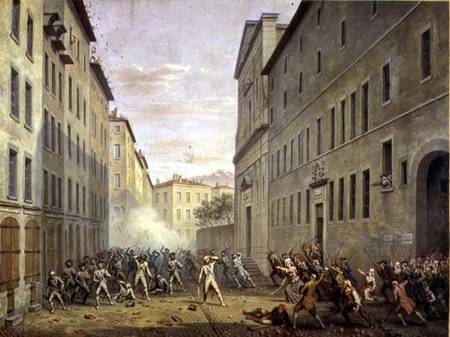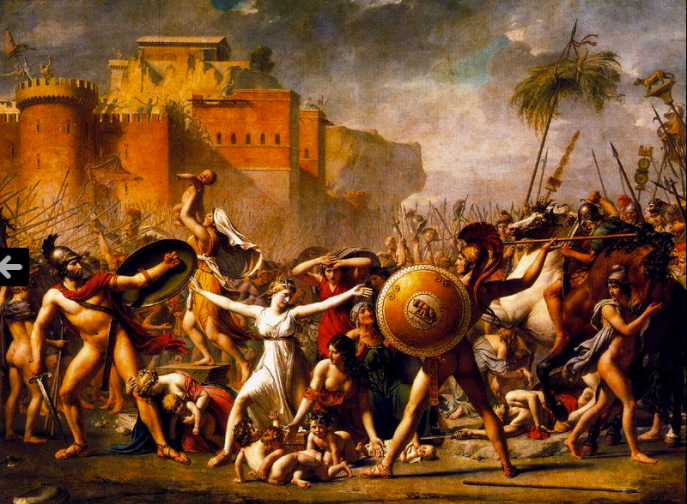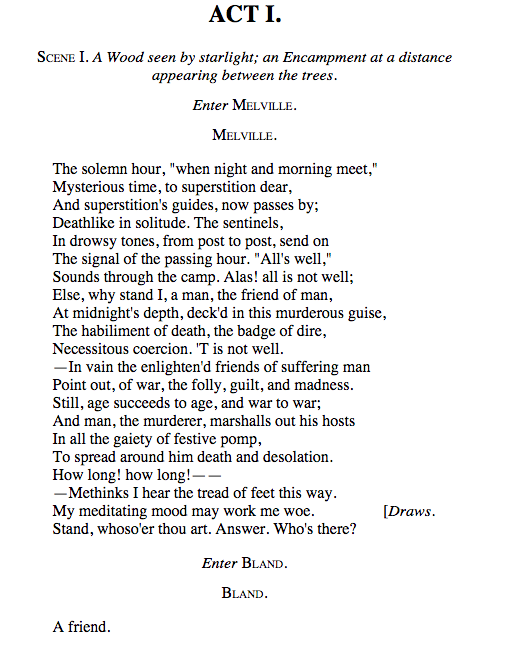Introduction: In Europe, the French Revolution inspired many artists. Nicolas Poussin was the center of their inspiration, thus the promotion of Poussiniste painting began. These particular artists who stemmed away from Rococo paintings believed that strong drawings were rational and therefore morally better. It was believed that art should be analytical rather than pleasing.
Visual Art #1:
This painting is called The Day of Titles created by Alexandre Debelle in 1889. (I realize this is not from the classical era per sé but it reflects an event that happened during that period and has some characteristics of classical art.) It depicts a real event that took place in Grenoble, France on June 7, 1788. It was one of the first revolts that preceded the French Revolution. Many historians argue that it was the start of it. Neoclassical paintings involved an emphasis on linear design as well as a depiction of classical events, characters, themes, settings, and costumes (Neoclassical Painting). Notice in this piece all persons are painted at the same degree of incline, meaning that they are all parallel. Even though this painting was painted a century after the fact, the costumes, settings, and I would assume characters are consistent with that of the real late 1780’s. This painting also tells a story of the French struggle for liberty by showing the events that happened that day. I feel that this painting is a great classical piece even if it was a few decades too late.
Visual Art #2:
This photo is titled The Intervention of the Sabine Women painted by Jacques-Louis David in 1799 in Paris, France. David was a famous neo-classical painter whose paintings during the 1790’s were aimed around the French Revolution, glorifying the leaders and martyrs (Campbell). This work is meant as a pendant to Poussin’s earlier work, Rape of the Sabine. In this painting, the Sabine women throw themselves in the middle of all the fighting and weapons, in which they separating their own fathers and husbands (the Romans vs. the Sabines). This painting was created just a few years after the Reign of Terror: a period of mass executions of enemies of the French Revolution in 1793-1794 (Spillan). Thus this painting is really about reconciliation, not just for the families in the painting, but for France itself. The country was torn at this point and civilians of France wanted it to become whole again. This painting is a stellar example of neoclassical characteristics.
Theater:
It surprised me to learn that during the American Revolution, plays were banned in most of the states by the Continental Congress. Since America was a new country, all plays were written by European-born authors. The Revolutionary period was a boost for dramatists, where heroism and satire played a leading role (Theater of the Untied States). That being said, there were no professional dramatists until William Dunlap who was so named “The Father of American Drama”. (Side note: “Cato” was a play about revolution performed by George Washington and his troops at Valley Forge in the winter of 1777 which I think is really cool. Even George Washington broke the rules sometimes!)
André is probably the most famous play written by William Dunlap. It was first performed at the Park Theatre in New York City in 1789 by the Old American Company. This play relates to the case of Major John André, the British officer who was hanged as a spy in 1780 for his role in the treason of Benedict Arnold. The play is a fictionalized account of the American debate over whether to spare or hang André (“André”_play). The play has three real historic characters: Major André, George Washington, and Honora Sneyd who was engaged to André ten years earlier. This play was one of the first about America’s history and it was very dramatic filled with betrayal and hard moral decisions. The story, though it is fiction, captures the anguish felt by many Americans over the hanging of a brilliant young officer. The play is also considered America’s first tragedy written on an American subject. The American Revolution was hard on all parties involved and this play shows that.
Works Cited
- Gersh-Nesic, Beth. “Neo-Classicism.” Smarthistory. Khan Academy, n.d. Web. 16 Oct. 2014. <http://smarthistory.khanacademy.org/neo-classicism.html>.
- Campbell, Wendy. “Neoclassical Art.” Daily Art Fixx. N.p., 30 Aug. 2011. Web. 17 Oct. 2014. <http://www.dailyartfixx.com/tag/neoclassical-art/>.
- Spillan, D. “David’s The Intervention of the Sabine Women.” Smarthistory. Livy, n.d. Web. 15 Oct. 2014. <http://smarthistory.khanacademy.org/davids-the-intervention-of-the-sabine-women.html>.
- “Theater of the United States.” Wikipedia. Wikimedia Foundation, 27 June 2014. Web. 17 Oct. 2014. <http://en.wikipedia.org/wiki/Theater_of_the_United_States>.
- “André (play).” Wikipedia. Wikimedia Foundation, 21 Aug. 2014. Web. 17 Oct. 2014. <http://en.wikipedia.org/wiki/André_(play)>.
- “Neoclassical Painting.” Neoclassical Painting: Definition, Characteristics. Visual Arts Cork, n.d. Web. 17 Oct. 2014. <http://www.visual-arts-cork.com/history-of-art/neoclassical-painting.htm>.



I really like how you put your blog together. Having the different headers really kept things easy to read, and you works cited are also really well done.
LikeLike
testing comments settings
LikeLike